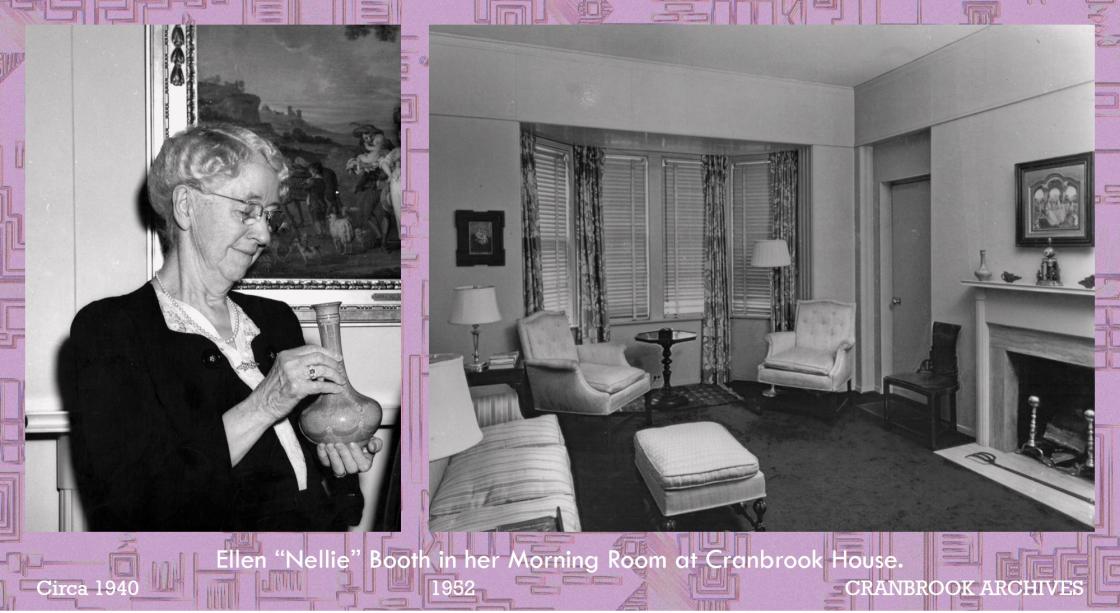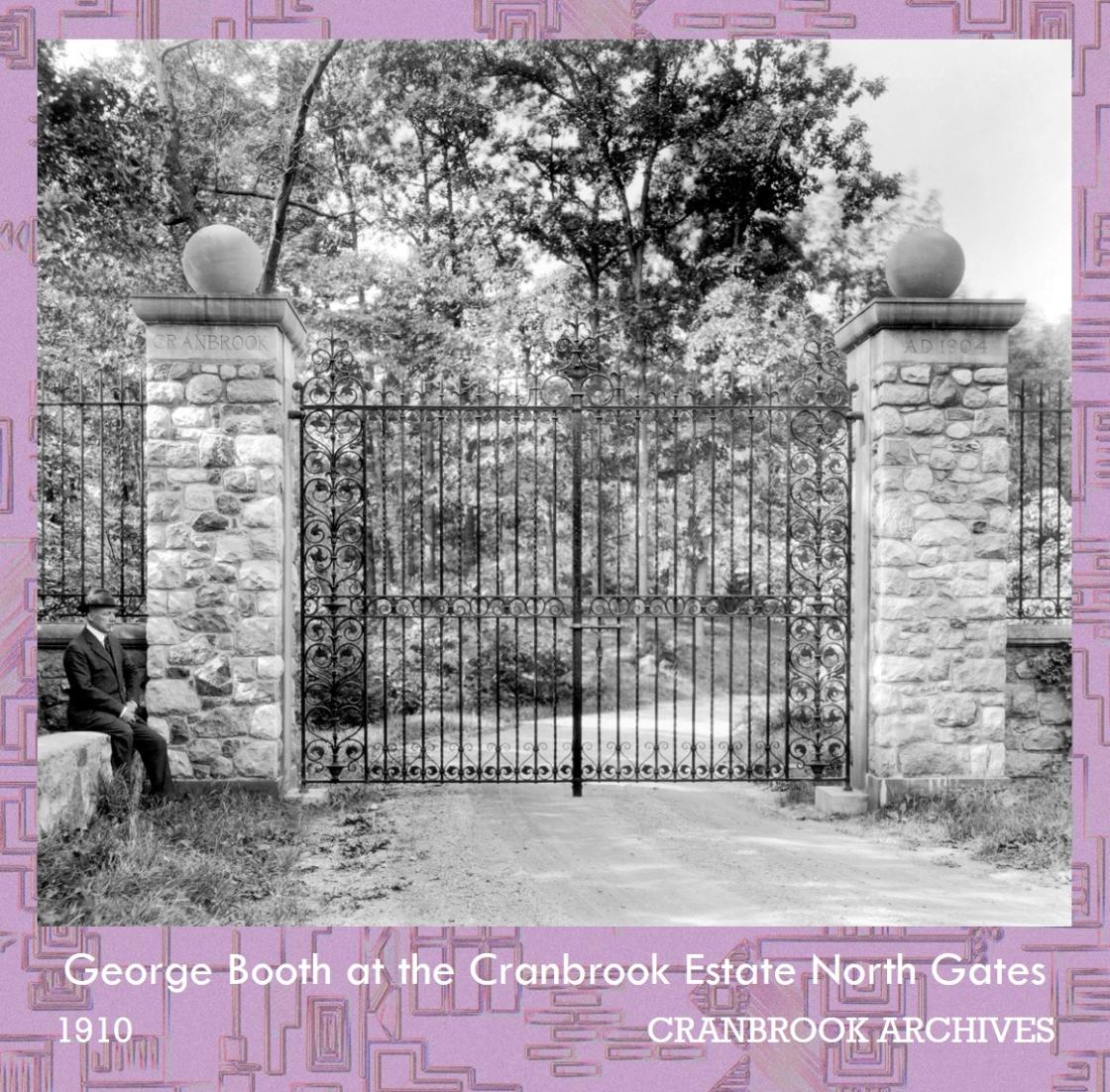CRANBROOK HOUSE
HOME OF GEORGE AND ELLEN BOOTH, 1908-1949
ALBERT KAHN, ARCHITECT
1908/1918/1919
Metalsmith and newspaper publisher George Booth and his wife, Ellen Scripps Booth, built this Arts and Crafts manor home as the centerpiece of their country estate, Cranbrook. The Booths outfitted the interior with fine examples of handcrafted furniture, textiles, metalwork, and sculpture, often purchased at the Detroit Society of Arts and Crafts downtown. It was from this home that the Booths envisioned and implemented the transformation of their personal estate into a multifaceted center of art, science, and education now known as Cranbrook Educational Community.
Just as George and Ellen Booth supported the work of artists and craftspeople with special commissions for their home, the pieces included here for Speculative Histories add stories and ideas important to the artists of Cranbrook Academy of Art today.
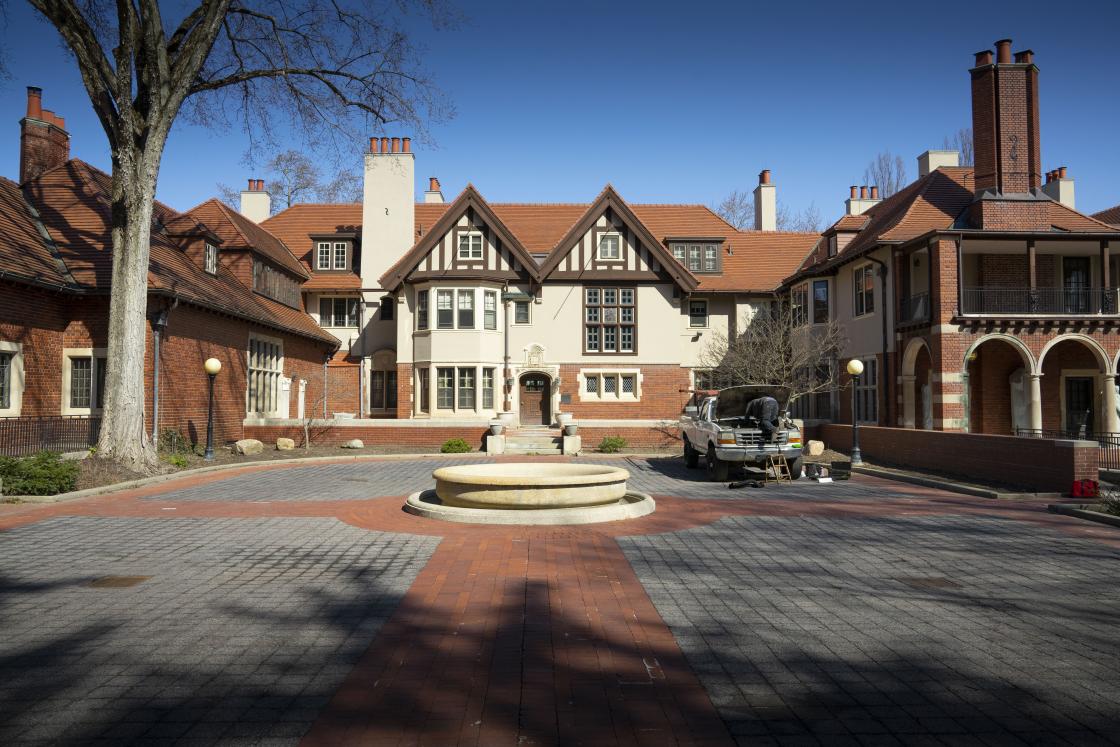
EXTERIOR
Into the courtyard of Cranbrook House, Steven Kuypers towed his beloved, but non-functional, Ford F-250 for a full day’s work. The performance piece brings to campus an everyday activity—maintenance of a vehicle—to a hyper-aestheticized space where such activity is rarely on view. As Kuypers asks, “Why do some people hang on to all their old cars rather than sell or scrap them? Where is the value in having more projects than you could get to in a lifetime? What objects do I hold onto despite their lack of worth by any rational metrics?”
1908 ROOMS
In the Booths’ Dining Room, Scott Klinker, 3D Design Artist-in-Residence, brings his Structures of Light to frame and double the fireplace. Side chairs begin to float futuristically as the neon redefines the understanding of the traditional room. 4D Design Artists-in-Residence Carla Diana adds her book, LEO the Maker Prince and 3D printed characters from the book into the Cranbrook Cabinet, made for the display of handmade books from George Booth’s Cranbrook Press (1900-1902). While Booth’s books represented a turn back toward the distinctly handmade, Diana’s book presents a future where robots and technology are the realm of every person: the characters were printed by a young reader from files accessed through codes within the book.
In George Booth’s Old Country Office, Kira Keck and Jane Sasso hoped to bring back the presence of Ellen (Nellie) Booth: this room was renovated into her Morning Room in the 1930s, yet restored back to George’s office in the 1990s. Alongside a dried flower arrangement and surrounding an historic pillow embroidered “Nellie,” the artists rehung Ellen’s drapes and incorporated surviving furniture and small items from the Morning Room. Keck and Sasso helped bring forward the story of Ellen, including the brutal (but misremembered) tale of murder among the finches or canaries of the aviary attached to the room.
In the Living Room, atop the large oriental rug, Jenna VanFleteren expanded and gave dimension to a single flower design from the rug, humorously commenting on history repeating itself in a new way. 2D Design Artists-in-Residence Elliot Earls added a group of works exploring his graphic figures around the fireplace in a manner suggesting Booth had continued collecting objets d’art well into this century. In an Italian curio cabinet, Merel Noorlander’s two robotic sex toys—one moving on a paper spiral, the other with a paper accordion—explore the relationship between organs, sexuality, and the design language of commercial sex toys. In the Sunset Room, Sylvain Malfroy-Camine added his portable painting-turned-light shade. He imagines the painting as a character in its own right, and its form mirrors the vertical thrust of the arm of Giambologna's bronze Mercury nearby.
Elliot Earls
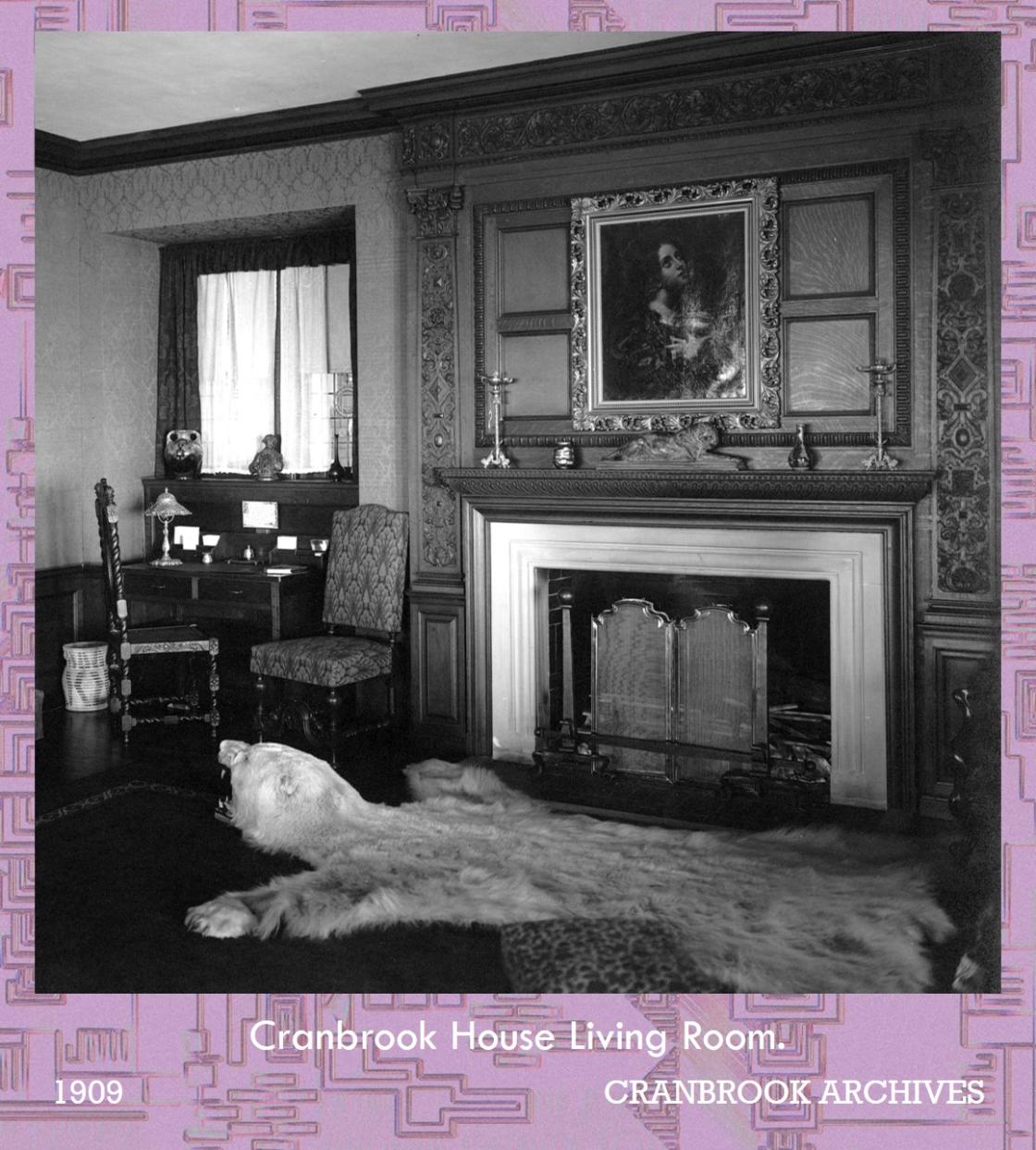
Elliot Earls, 2D Design Artist-in-Residence
Wood, cast bronze, mixed media
Dimensions variable
2006-2021
Cream
Elliot Earls, 2D Design Artist-in-Residence
Oil on linen
18 x 24 x 2 inches
2014
Shown with (left to right):
Toy Venus, John Gregory, 1923, Bequest of George Gough Booth and Ellen Scripps Booth through the Cranbrook Foundation
Vase, Odette Chatrousse or Auguste Heiligenstein, before 1929, Collection Cranbrook Art Museum
Argenta Ware Vase, Wilhelm Kage, circa 1930, Collection Cranbrook Art Museum
Night, Mario Joseph Korbel, 1921, Bequest of George Gough Booth and Ellen Scripps Booth through the Cranbrook Foundation
Vase, Unknown (Japanese), 1800-1899, Bequest of George Gough Booth and Ellen Scripps Booth through the Cranbrook Foundation
Statue (Standing Woman Playing Lute), Anton Pospisil, early 20th Century, Bequest of George Gough Booth and Ellen Scripps Booth through the Cranbrook Foundation
LIBRARY
At one end of the grand Cranbrook House Library, added onto the house in 1918, hangs The Great Crusade tapestry by Albert Herter. Elliot Avis responded to the tapestry’s scene of General Pershing marching into the Great War alongside an amalgam of European war, political, and religious heroes with his speculative chess set. As Avis writes, “Chess is an ancient game, a violent game, a metaphor for war and life.” Maria Bologna describes her work as a souvenir from an imagined trip by George Booth to a local paper mill, where the cardboard roll fell from the rafters to his feet. Fascinated, Booth now can sit and stare into the form. A large ceramic vessel with a non-functional lid, Sage Rucci’s Platonic Imposter questions displays of wealth and art for the sake of status: what makes an object luxurious?
Hanging from the fireplace screen is a view of a late-20th century home office, its clean lines and fax machine a strong break from the Booths’ own grand library workspace. Cooper Holoweski, Print Media Artist-in-Residence, depicts his father’s work as a gallerist of Ed Ruscha and Robert Mapplethorpe in this digital collage. On the library’s desk, Emily Fruth has placed a letter covered in strange sores, “made in contemplation of the experiences that get under our skin, unspoken words that still remain festering, boiling within us.”
Chelsea Romeo Allen tapped into her decade of work in the food service industry with her cast-hand candles, positioned to hold serving trays. Recalling, too, the large staff it took to operate an estate like Cranbrook House, these unbalanced sculptures represent the physical and economic precarity associated with the service industry. Along the bookshelves, Meirav Ong hung twelve bookmarks made of bedikot (Jewish menstrual cloths) embroidered with both the Zodiac (which appears carved along the Library’s wood paneling) and the twelve tribes of Israel regendered as women. Intrigued by the bookshelves’ grouping of religious texts alongside Other People’s Daughters, a feminist social reform text by Eleanor Wembridge, Ong imagines how Judaic culture would be different as a matriarchal society.
Elliot Avis
Elliot Avis, Painting 2022
Scagliola, mortar, shellac
12 x 12 x 5 inches
2021
Shown with:
The Great Crusade
Albert Herter, Herter Looms, Inc., (maker)
Cotton, wool and silk tapestry
156 x 120 inches
1920
Gift of George Gough Booth and Ellen Scripps Booth, Collection Cranbrook Art Museum
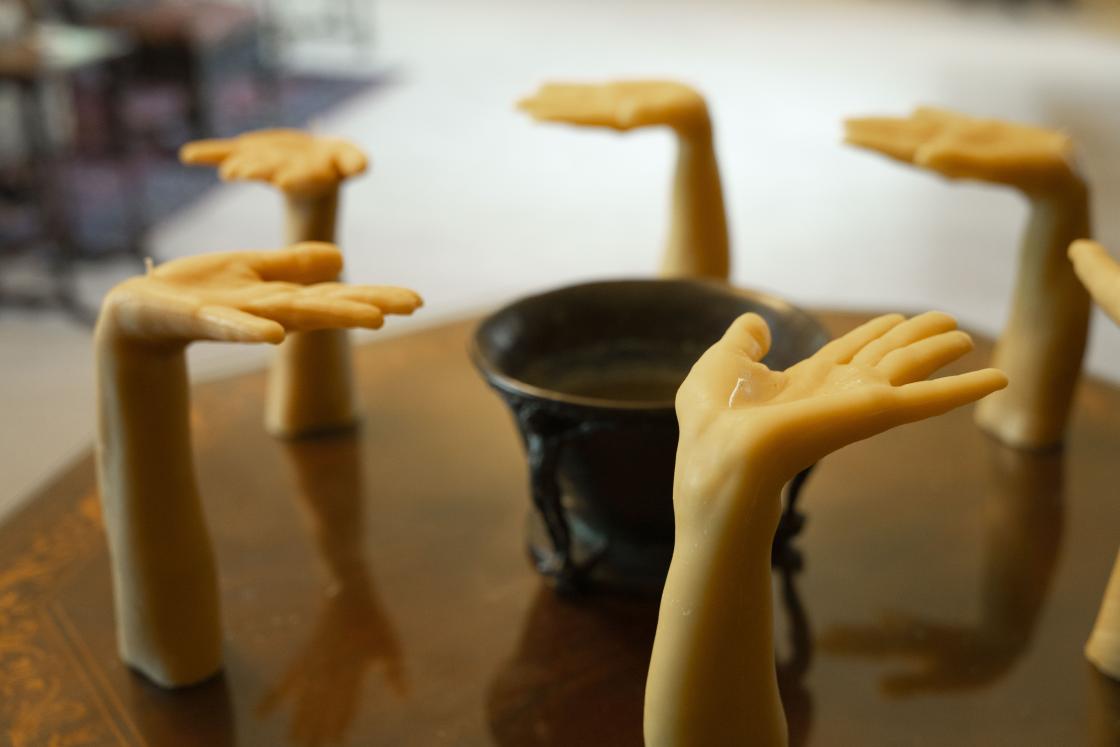
GEORGE BOOTH’S OFFICE SUITE
Within George Booth’s 1918 office, where objects from the family’s travels are on display, Yi Ding hung a canvas of gilt Chinese poetry as a way of bringing her country’s culture into the space—including a topical poem about a child going abroad to school. In Booth’s drafting room, where a double portrait of George and Ellen Booth hangs, Mieyoshi Ragernoir’s double portrait celebrates relationships between Black women throughout history. Ragernoir writes that “Ancestral hands hover beside and behind radiant femmes as their divine watchers.” She continues, “My last name is signed largely on the front in an artistic style to indicate me boldly being present." Behind the painting, the artist’s coveralls, splattered with paint, read “PAY BLACK FEMMES.”
In the same room, Ryan David’s Observation Map sits under the first site plan of the Cranbrook estate from 1904. David created his map through walks around campus, marking areas and interactions of interest, including his discovery of the original North Gate pillars on Cranbrook Road. A single fallen rock from these pillars was removed and cast by the artist in a series of different materials. The rock will be etched with a message and returned to the pillars when they are reconstructed this summer. In the Still Room, where Booth retired for afternoon naps, Emily Fruth’s wax bowl shows the imprint and remnants of the strawberries around which it was cast—reflecting the way in which we all hold the imprint of the memories of people long after they are gone.
Mieyoshi Ragernoir
Mieyoshi Ragernoir, Painting 2022
Oil painting collaged on spray painted canvas
36 x 24 inches
2020-2021
Shown with:
Portrait of Mr. and Mrs. George G. Booth
Zoltan Sepeshy, CAA Instructor/Director of Painting, 1931-1966, CAA Director/President 1946-1966
Tempera, wood frame
35½ x 43½ inches
Circa 1951
Collection Cranbrook Art Museum
PHOTO CREDITS
Color photography by Eric Perry, Courtesy Cranbrook Center for Collections and Research.
Historic photographs Cranbrook Archives, Cranbrook Center for Collections and Research.



